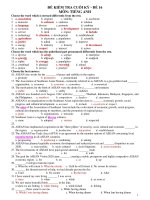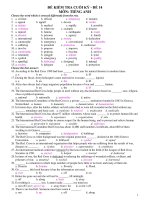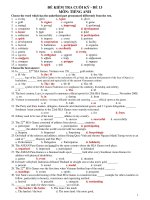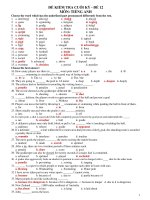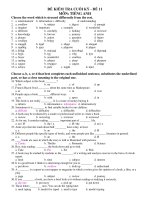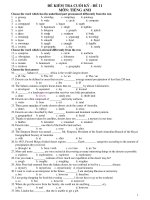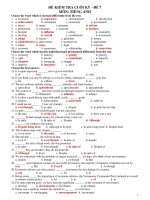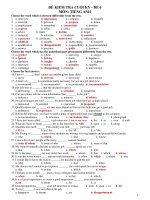- Trang chủ >>
- Khoa Học Tự Nhiên >>
- Vật lý
Cuối kỳ Vật lý 2( Tiếng Anh )
Bạn đang xem bản rút gọn của tài liệu. Xem và tải ngay bản đầy đủ của tài liệu tại đây (1023.06 KB, 8 trang )
FINAL PHY2
1/
2/
n = 0.1 moles
V = 2.5 𝑑𝑚3 = 2.5 𝑥 10−3 𝑚3
3V = 7.5 𝑑𝑚3 = 7.5 𝑥 10−3 𝑚3
P1 = 105 𝑃𝑎
𝑅=
25
𝐽/(𝑚𝑜𝑙𝑒. 𝐾)
3
𝛾 = 1.5
a) T1 =
𝑃𝑉
𝑛𝑅
=
105 𝑥 (2.5 𝑥 10−3 )
0.1 𝑥 8.314
= 300.7 𝐾
P1V1 = P2V2 (Chỗ này giống isothermal(Đẳng nhiệt))
Nhiệt độ lúc này chưa thay đổi mà chỉ có áp suất)
V(after the expansion) = V + 3V = 10 𝑑𝑚3 = 10 𝑥 10−3 𝑚3
P1V1 = P2V2
105 𝑥 (2.5 𝑥 10−3 ) = 𝑃2 𝑥 (10 𝑥 10−3 )
P2 = 25000 Pa
b) Adibatic process : 𝑇1. 𝑉2𝛾−1 = 𝑇2. 𝑉3𝛾−1
V2 = (10 𝑥 10−3 ) 𝑚3
V3 = ( 2.5 𝑥 10−3 ) 𝑚3 (Because the piston back to its initial
position)
300.7 𝑥 (10 𝑥 10−3 )1.5−1 = 𝑇2 𝑥 (2.5 𝑥 10−3 )1.5−1
T2 = 601.4 K
3/
T = 273 K
R = 8.314
P = 1.0 𝑥 10−2 𝑎𝑡𝑚 = 1013.25 Pa
d = 1.24 𝑥 10−5 𝑔/𝑐𝑚3 = (1.24 x 10^-5) x 10^6 : 10^3 = 0.0124 kg/m^3
Pascal đi với kg/m^3
a) vrms = √
3𝑅𝑇
𝑀
=√
3𝑃
𝑑
= √
3 𝑥 0.082 𝑥 273
𝑀
=√
3 𝑥 1013.25
0.0124
= 495 m/s
b) vrms = √
3𝑅𝑇
𝑀
−→ 𝑀 = 0.028 kg/mol = 28 g/mol
c) M = 28g/mol N2
4/
n = 1 mole
P(A) =
𝑃0
2
=
105
2
Pa
P(B) = P0 = 105 𝑃𝑎
P(C) = 3P0 = 3 x 105 Pa
V(A) = V(B) = V0 = 1 𝑚3
a) From A B (Isochoric = V constant)
V(A) = V(B) = 1 𝑚3
From B C (Isothermal = T constant)
P(B) x V(B) = P(C) x V(C)
105 x 1 = 3 x 105 x V(C)
V(C) = 1/3 𝑚3
b) Adibatic process from C to A
P(C) x 𝑉 (𝐶 )𝛾 = 𝑃(𝐴) 𝑥 𝑉(𝐴)𝛾
1
105
3
2
(3 x 105 ) 𝑥 ( )𝛾 =
1
1
3
6
( )𝛾 =
1
𝛾 = log 1 = 1.631
3
6
𝑥 1𝛾
5/ At very low temperatures, the molar specific heat Cv of many solids
is approximately Cv = 𝐴𝑇 3 , where A depends of the particular
substance. For aluminum, A = 3.15 𝑥 10−5 𝐽 𝑚𝑜𝑙 −1 𝐾 −4 . Find the
entropy change for 4.0 mol of aluminum when its temperature is raised
from 5.0 K to 10.0 K
The formula for an entropy change: dS =
𝒅𝑸
Equation: dQ = NCv(T + dT – T)
dQ = 𝑁𝐶𝑣 (𝑇)𝑑𝑇 (2)
(1)(2) dS =
𝑁𝐶𝑣(𝑇)𝑑𝑇
𝑇
Integrate both sides ∆𝑆 = 𝑁 ∫
We have : Cv(T) = 𝐴𝑇 3
𝐶𝑣(𝑇)𝑑𝑇
𝑇
𝑻
(J) (1)
∆𝑆 = 𝑁 ∫
𝐴𝑇 3 𝑑𝑇
𝑇
2
= 𝑁𝐴 ∫ 𝑇 𝑑𝑇 = 𝑁𝐴
= 4 x (3.15 x 10^-5) x
103 −53
3
∆𝑇 3
3
= NA
𝑇23 −𝑇13
3
= 0.03675 J
Other question 5:
𝑇2 𝑑𝑄
The formula of entropy change : ∆S = ∫𝑇1
𝑇
dQ = mc𝑑𝑇
𝑇2 𝑚(𝑎+𝑏𝑇)𝑑𝑇
∆S = ∫𝑇1
𝑇
𝑇2 𝑚𝑎
= ∫𝑇1
𝑇
+ 𝑚𝑏 = 𝑚𝑎𝑙𝑛(𝑇) + 𝑚𝑏𝑇
= 3 x 770 x ln
dS =
𝑑𝑄
𝑇
(J/K) (1)
dQ = mCvdT (2)
(1)(2) dS =
𝑚𝑐𝑑𝑇
𝑇
With c = a+bT. Thus :
𝑇2 𝑚(𝑎+𝑏𝑇)𝑑𝑇
Integrate both side : ∆𝑆 = ∫𝑇1
𝑇
𝑇2
= ∫𝑇1 (𝑚𝑎𝑇 −1 + 𝑚𝑏)𝑑𝑇
= maln(T) + mbT
= maln(600/300) + mb(600-300)
=3x

